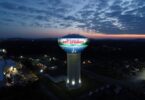Part of managing the water cycle is the challenging task of handling the systems and processes that enable urban water supply, water reuse, sanitation, and irrigation. In each of these stages, process automation is one of the technological opportunities with the greatest potential to enhance the current water scenario.
The significant upsides for utilities include better operations and management, lower costs, and added value. Global Water Intelligence’s 2019 ‘Accelerating the Digital Water Utility’ report says the return on investment from automating operations can be as high as 14%.
Integrating data into innovative, vendor-agnostic technological solutions is the first step towards more preventive, automatic management across a range of fields, such as extreme events, drinking water treatment plants (DWTP), wastewater treatment plants (WWTP), and smart irrigation.

Preparing for and warning about extreme events
Droughts, storms, and floods, all water-related incidents, top the list of disasters over the past 50 years. Hence “more and more utilities are choosing to deploy smart technological solutions to mitigate the damage and operational costs of these events,” says Jorge Helmbrecht, Business Development Director de Idrica
The implementation of sensors, historical data analysis, and weather and hydrological prediction models enable the solutions to identify potential events based on threshold exceedances. These data, which may be internal or external, coupled with the use of mathematical models mean analyses can be performed to simulate scenarios and support decision-making. “Automation is a key part of early warning systems whose return on investment is up to ten times their cost,” stated Helmbrecht.
Automating drinking water treatment plants
In contrast to the control of the various DWTP processes in isolation, “digital transformation paves the way to centralized data management,” added Miren Aldecoa, Water Treatment & Desalination Consultant de Idrica. In advanced predictive control, the algorithmic models learn and solve by predicting and optimizing processes and can automate them without human intervention.
Use cases include forecasting the quality of the water collected, automating dosing for coagulation, simulating the properties of stored chemicals, monitoring decanters, and optimizing filtration and pumping.
According to the international water technology company, in the future we will see progress in the detection of events that may occur in water supply networks. will see breakthroughs in detecting events that take place in supply networks from the treatment plant and/or storage tank outlet to the point of consumption. This will be accomplished by automating and monitoring significant water quality variables. Water health criteria will thus be expanded beyond viruses and bacteria (SARS-CoV-2, legionella, etc.).
This makes it all the more imperative to roll out digital platforms that integrate and analyze dispersed data to break down operational silos, shift towards centralized, automatic control of the plant, and simplify decision-making.
Improving WWTP operations
Wastewater treatment plants (WWTPs) are facing new challenges. Stricter quality requirements for plant effluent and sludge quality alongside calls to cut greenhouse gas emissions, smells, and noise are making running them more complex.
The digital industry brings new options for improved connectivity and operations, further enhancing centralized work. “Fitting equipment with sensors and the subsequent integration of internal (LIMS, CMMS, SCADA, field devices, etc.) and external (weather data, social media) data will optimize WWTPs in terms of quality, the environment, and operating costs,” argued Pablo Montalvillo, Wastewater Digitalization Consultant at Idrica.
By using algorithms and mathematical models applied to this data, utilities can receive recommendations on actions to be taken, anticipating potential problems and optimizing the processes involved in the plant. Idrica also points out that the trend is to implement systems that can automatically trigger any actions required in the plant, resulting in operational improvements, robustness, and lower costs.
Irrigators invest in smart irrigation automation
Automating agricultural irrigation is designed to shrink the water footprint, promote environmental sustainability, and optimize the costs incurred in the business. The starting point is smart irrigation, which means irrigating on the basis of the real needs of the crops while factoring in the humidity and type of soil, climate conditions, and weather forecasts. Technological solutions show when and how much to irrigate by harnessing remote sensing plus information from sensors placed in the fields to calculate the water balance.
Nonetheless, “automatic adjustment of agricultural irrigation scheduling goes one step further,” noted Jorge Helmbrecht. More and more irrigation associations are automating this process. One of the main drivers is enhanced environmental sustainability since optimizing water use also cuts energy usage.
To make this happen, all network assets need to be monitored by fitting equipment with sensors. This year, Idrica expects irrigation associations to invest in digitally transforming their infrastructures and rolling out new technological solutions that can tap into data to achieve greater sustainability.
Related articles:
Idrica launches new solutions and expands its GoAigua platform to cater for other areas of the water cycle







